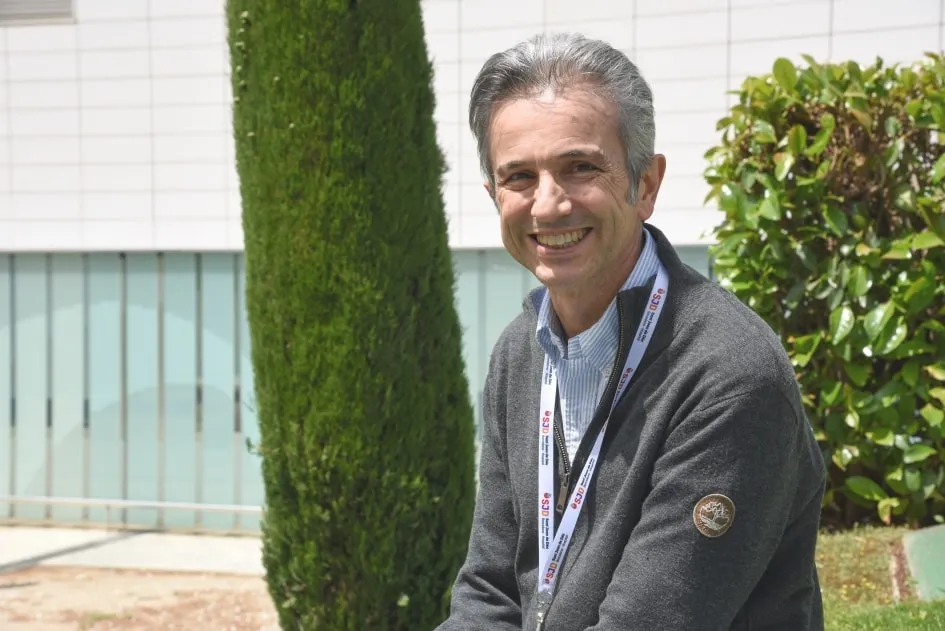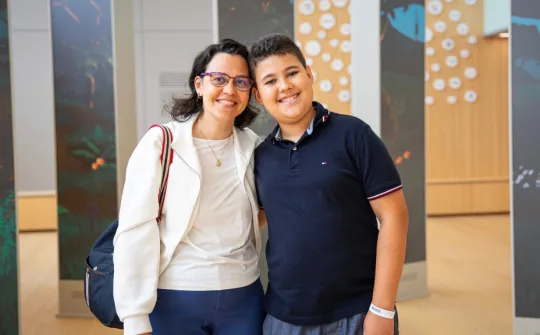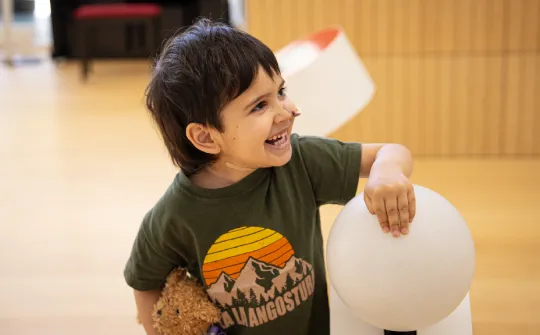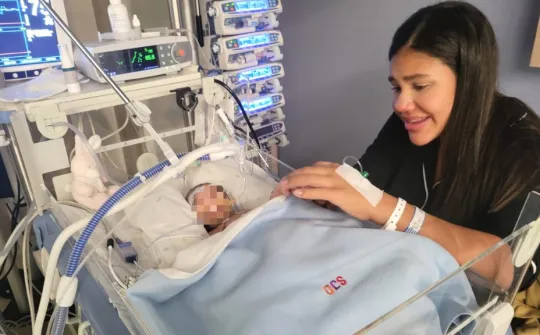“The goal is for all the children in the world to overcome a cancer that has a cure: retinoblastoma”

Guillermo Luís Chantada, oncologist and haematologist at SJD Barcelona Children’s Hospital explains his work in research and treatment for retinoblastoma
Guillermo Luís Chantada, an oncologist and haematologist at SJD Barcelona Children’s Hospital, specialised in haematology and oncology in 1995 at Garrahan Hospital (Argentina), where he has been an oncologist and haematologist since 1996. He has had stays in several North-American reference centres. In 2013 he became a part-time member of the medical team associated with the Oncology and Haematology Department of SJD Barcelona Children’s Hospital, where he coordinates the retinoblastoma research and treatment group. His main areas of research are retinoblastoma, neuroblastoma, lymphomas and histiocytosis.
What is your main role at SJD Barcelona Children’s Hospital?
I am a pediatric oncologist and I devote myself mainly to investigating retinoblastoma tumours, but I also dedicate part of my working day to managing international partnerships and, more specifically, here at SJD Barcelona Children’s Hospital, mainly through the Leo Messi Foundation. One of my goals is to achieve partnerships with other hospitals in Latin America with a view to maintaining professional synergies that are enriching for everyone. These synergies are very significant in the training of professionals, particularly in oncology.
Since 2015, when this international cooperation programme got under way, seventy Latin American professionals have come to train at SJD Barcelona Children’s Hospital. Another of my tasks is to coordinate the European retinoblastoma network and I am also tasked with building bridges with other European institutions.
How do you combine your activity at Garrahan Hospital in Argentina and SJD Barcelona Children’s Hospital?
The fact that today we can work remotely has really changed the professional scene. Sometimes I don’t know if I’m in Buenos Aires or in Barcelona, since it is difficult to invest a given period of time to each project with any degree of accuracy. Physically, I spend more time in Argentina than here, but thanks to the new communication tools, I am always everywhere. For example, I may be doing web sessions on retinoblastoma from Garrahan Hospital, to doctors who are all in Barcelona.
What differences do you perceive between these two hospital systems?
In Argentina, around 60% of the population have no type of health coverage, and Garrahan Hospital, where I work, is a hospital that attends precisely to this population, which is very economically disadvantaged. We treat people who live in extreme situations of poverty. So, we could say that both hospitals are very similar in terms of the internal management of the centre, but the socio-economic situation of the patients is very different.
Could you give us some of the key points about retinal cancer?
Retinoblastoma is a very rare type of cancer in children. It is a tumour that only young children have, especially in the first two years of life, because it is related to the development of eye cells. The fact that this tumour grows in an organ in which, a priori, families can detect it more easily, has a certain advantage. Parent’s don’t always know how to express it, but they notice that there is something strange in their child’s eye, like a spot or a reflection.
However, in certain cases, the fact that the tumour appears in the eye makes it more difficult to diagnose. Children are small, they can’t keep still, and when the pediatrician examines them with light, the pupil contracts and the spot disappears. At the same time, it is difficult for adults to detect loss of vision in an infant. Now there is an application, still under development, which uses a photo of the child’s eye to determine whether they are suffering from eye cancer.
It is not about saving lives, because in Europe, almost all children with retinoblastoma overcome it, but about saving more eyes.
How did you start the research project at SJD Barcelona Children’s Hospital?
SJD Barcelona Children’s Hospital was the first centre in Europe to adopt intra-arterial chemotherapy as a treatment. We made a very strong commitment based on studies conducted at Memorial Sloan Kettering Cancer Center in New York, with which we were already cooperating. The rest of the centres only used intravenous chemotherapy. In 2012 we began to develop a line of research on retinoblastoma that would allow us to find alternatives to improve results.
It is not about saving lives, because in Europe, almost all children with retinoblastoma overcome it, but about saving more eyes, and for children who suffer from retinoblastoma to come out of it with good eyesight. At the same time, and no less importantly, we need to ensure that these children do not have any cosmetic after-effects that may lead to problems of low self-esteem in the future.
And then you started carrying out research with the oncolytic virus.
Thanks to the use of intra-arterial chemotherapy, we no longer use radiotherapy, which was much more aggressive. Now we save many more eyes and we have also managed to significantly improve the results, both cosmetically and functionally. Even so, there are still eyes that unfortunately we cannot save. It was at this point when, along with Dr Ramón Alemany, principal investigator in resistance, virotherapy and immunotherapy of the ICO ProCURE programme, and Dr Manel Cascalló, general manager of VCN Biosciences, we decided to start working on a new line of research based on the oncolytic virus.
This research brought you very promising results for combating retinoblastoma.
Together with Dr Ángel Montero Carcaboso, a pediatric oncology researcher at SJD Barcelona Children’s Hospital, and Guillem Pascual Pastó, a researcher at the centre’s Onco-Haematology Laboratory, we began to carry out preclinical trials to learn about the activity of this virus We wanted to know if it could kill cancer cells in a test tube, and we saw that it did. Then we tested it with laboratory animals, to see if it also worked. And it did. Then we tested it with seven more lines of research, and we also achieved positive results.
Subsequently, we had to do a very thorough job related to the safety of this entire process, since we had to be totally convinced that, if we injected the virus into a child’s eye, we could be sure that it would have no unexpected effects. This whole process took many years and it was finally published in the journal Science Translational Research. A huge number of collaborators made this research possible. From that point on, we started treating patients.
Why a virus?
The whole reason why viruses exist is to infect cells in order to replicate and keep its species alive. This same mechanism of survival is the one that we use in our favour. We take advantage of the virus to eliminate malignant cells, using its innate ability to infect, reproduce and perpetuate its species. The aim is to ensure that, as it spreads, it kills cancer cells too. But the main problem is that humans have their own immune system designed precisely to fight viruses. Therefore, when the body detects a virus, it sends lymphocytes to fight it.
This means we always have to play around with people’s immune systems and, therefore, they are usually weaker patients immunologically speaking. The key is to manage to fight the tumour before the patient’s own immune system prevents us from doing so. It is an ideal treatment for fighting a retinoblastoma, as it is confined to one single spot, where the immune system is not very strong, and because young children are not naturally immune to this virus.
Every year 8,000 cases of retinoblastoma are diagnosed worldwide: 3,000 of these children will die because of the tumour. The survival rate depends on the child’s country of origin.
What is your professional objective right now?
Every year 8,000 cases of retinoblastoma are diagnosed worldwide: 3,000 of these children will die because of the tumour. The survival rate depends on the child’s country of origin. Children in developed countries, such as Australia, the United States, European countries and the southern part of Latin America, are saved, but for the rest it is not so easy. So, if you ask me about the future, as far as I’m concerned, it involves curing these 3,000 children who today are still not cured.
Therefore, the first thing on our minds is that all children should have the same chance of being cured. We also want to improve the results achieved and, above all, have increasingly personalised treatments. Chemotherapy fights any cell it encounters: the bad ones, but the good ones, too. So we are totally committed to finding more specific treatments which will save the lives of children with retinoblastoma and which, in addition, will not adversely affect their futures.
How will the launch of the new SJD Pediatric Cancer Centre Barcelona influence your work?
These treatments will be offered to the SJD Pediatric Cancer Centre Barcelona to offer children access to cutting-edge treatments. It will be a worldwide centre open to everyone, and this is also the mission of our study.



